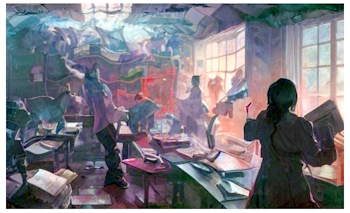
We all perceive the world through our own little bubbles. As far as our senses go, we only have touch, taste, feeling, hearing, smell and sight to go by. The rest comes from what we glean through those things, be it other people, technology, language, culture, etc.
If the bubble is too small, we feel it a prison and do our best to expand it. Once it’s comfortable, we don’t push it outward as much.
These little bubbles contain ideas that have passed down through the generations, how others have helped us translate our world and all that is in it, etc. We’re part of a greater distillation process, where because of our own limitations we can’t possibly carry everything from previous generations.
If we consider all the stuff that creates our bubble as little bubbles themselves that we pass on to the next generation, it’s a distillation of our knowledge and ideas over time. Some fall away, like the idea of the Earth being the center of the Universe. Some stay with us despite not being used as much as we might like – such as the whole concept of, ‘be nice to each other’.
If we view traffic as something going through time, bubbles are racing toward the future all at the same time, sometimes aggregating, sometimes not. The traffic of ideas and knowledge is distilled as we move forward in time, one generation at a time. Generally speaking, until broadcast media this was a very local process. Thus, red dots trying to get us to do things, wielded by those who wish us to do things from purchasing products to voting for politicians with their financial interests at heart.
Broadcast media made it global by at first giving people information and then by broadcasting opinions to become sustainable through advertising. Social media has become the same thing. How will artificial intelligences differ? Will ChatGPT suddenly spew out, “Eat at Joes!”? I doubt that.
However, those with fiscal interests can decide what the deep learning of artificial intelligences are exposed to. Machine learning is largely about clever algorithms and pruning the data that the algorithms are trained on, and those doing that are certainly not the most unbiased of humanity. I wouldn’t say that they are the most biased either – we’re all biased by our bubbles.
It’s Pandora’s Box. How do we decide what should go in and what should stay out? Well, we can’t, really. Nobody is actually telling us what’s in them now. Our education systems, too, show us that this is not necessarily something we’re good at.



